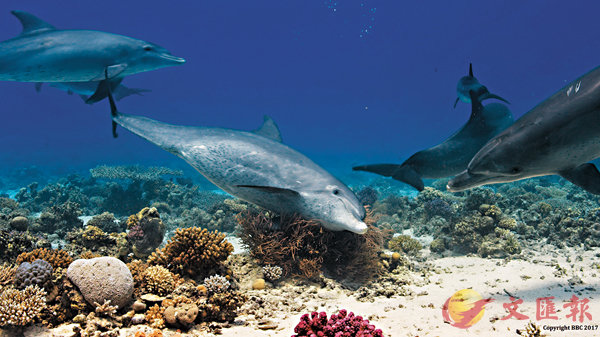 ■科學家發現不少樽鼻海豚身上的致病源對至少一種抗生素出現抗藥性反應。 資料圖片
■科學家發現不少樽鼻海豚身上的致病源對至少一種抗生素出現抗藥性反應。 資料圖片【原文】下文摘錄自香港《文匯報》9月17日報道:人類濫用抗生素(antibiotic),惡果卻要海豚來承受。美國最新一項研究發現,在佛羅里達州(Florida)外海生活的樽鼻海豚(bottlenose dolphin)身上致病源(pathogen)中,多達88.2%對至少一種抗生素出現抗藥性(drug resistance)反應,與人類的抗藥性情況相近,成為人類活動對海洋生態(marine ecology)影響的又一例證。
佛羅里達大西洋大學(Florida Atlantic University)及多間院校的研究團隊,於2003年至2015年間從佛州東南岸的印第安河潟湖(Indian River Lagoon)的171條樽鼻海豚身上,抽取733種致病源的樣本,再以17種常見抗生素作測試,得出令人憂慮的結果。
整體而言,733種致病源當中,多達88.2%至少對一種抗生素出現抗藥性反應。在出現抗藥性的致病源中,91.6%對於常用來治療某些性病的紅霉素(erythromycin)有抗藥性,77.3%則對氨芐青黴素(ampicillin)、61.7%對噻孢霉素(cephalothin)有抗藥性。更令研究人員憂慮的是,在研究進行的13年間,出現抗藥性的致病源比率不斷增加,例如對抗生素環丙沙星(ciprofloxacin)產生抗藥性的大腸桿菌(E coli)便在這段期間增加一倍。
研究人員表示,樽鼻海豚抗藥性致病源比率的增長趨勢,與人類的趨勢(trend)相似,尤其是醫院內的情況。相信這是因為印第安河潟湖一帶人口密集,抗生素及抗藥性致病源經生活污水(sewage)排放到海中所致,研究報告領頭作者謝弗(Adam Schaefer)表示,抗藥性致病源進入潟湖後,侵佔原有正常致病源的棲息環境,「沒有抗藥性的病菌死了,有抗藥性的則留下並增殖(proliferate),產生一群抗藥性致病源,並入侵海豚體內。」
研究反映大自然中抗藥性致病源的分佈已經超過人類想像,並正影響其他生物(organism)。研究人員指出,這次發現不單是關於樽鼻海豚的健康,更對人類健康有警示作用,因為海豚是海洋生態體系當中的指標物種(sentinel species),就有如「煤礦坑(coal mine)的金絲雀(canary)」,如果海豚體內抗藥性致病源增加,意味人類也可能透過海洋活動感染這些「超級病菌」(superbugs)。研究人員認為,這顯示人類有必要加強保持沿岸水域清潔。
世界衛生組織(World Health Organization)今年初將抗藥性致病源問題列為全球十大健康威脅之一。美國疾病控制及預防中心(Centers for Disease Control and Prevention)資料顯示,抗藥性致病源每年在美國造成約2.3萬人死亡。
Antibiotic resistance is on the rise among dolphins
【譯文】The abuse of antibiotics is now posing huge negative impacts on dolphins. A research in the United States studied the pathogens found in the samples of bottlenose dolphins inhabiting the ocean near Florida, and found that as many as 88.2% of the samples contained pathogens resistant to at least one antibiotic, similar to the drug resistance of human beings, showing another example of the negative impact of human activities on the marine ecology.
A group of researchers of the Florida Atlantic University in collaboration with a number of institutes and universities, conducted a unique study from 2003 to 2015 to collect 733 samples of pathogens isolated from 171 bottlenose dolphins in the Indian River Lagoon on the southeastern coast of Florida, followed by the tests involving 17 antibiotics. Yet, worrying results were found.
Overall, 88.2% of the 733 samples had pathogens that resisted at least one antibiotic, and among the isolates with antibiotic resistance, 91.6% were resistant to erythromycin commonly used for the treatment of a number of sexually transmitted infections, 77.3% were resistant to ampicillin and 61.7% to cephalothin. What worried researchers most was that the proportion of antibiotic-resistant pathogens had been increasing over the 13 years of the study, for example, resistance to the antibiotic ciprofloxacin among E coli isolates had more than doubled during the sampling periods.
The researchers said the significant rise of antibiotic resistance among bottlenose dolphins was in fact mirroring trends in human infections, especially in hospitals. It was believed that the area near the Indian River Lagoon had a huge human population on the coast and the resistant bacteria often entered the lagoon through sewage discharge. The study's lead author Adam Schaefer said the antibiotics created selective pressure on the normal bacteria after entering the lagoon, "the bacteria that are not resistant die, and resistant bacteria remain and proliferate, essentially creating a population of resistant pathogens that dolphins are exposed to."
The results showed that the distribution of drug-resistant pathogens in nature might go beyond human imagination, and was posing serious threats to other organisms. The researchers said that the study not only showed the care for the health condition of bottlenose dolphins, but also a warning to public health, as bottlenose dolphins were valuable sentinel species in the marine ecosystem, resembling "canary in the coal mine", such that if the drug-resistant pathogens in dolphins increased, it was expected that the possibility of people being infected with "superbugs" through marine activities would also increase. Therefore, it was essential and strongly recommended to improve the cleanliness of coastal waters.
The World Health Organization has named antibiotic resistance as one of the world's top 10 global health threats early this year. According to the U.S. Centers for Disease Control and Prevention, at least 23,000 people die from antibiotic-resistant infection in the country every year.■龐嘉儀
Q&A
1. 人類最早發現的抗生素是什麼?
2. 承上題,該抗生素於1928年由誰人發現?
3. 該抗生素的研究團隊於1945年獲頒什麼獎項?
4. 世界衛生組織警告,到2025年,耐藥性疾病每年可導致多少人死亡?
Answer
1. 青霉素 (Penicillin,或音譯盤尼西林)
2. 英國醫生及科學家亞歷山大弗萊明爵士 (Sir Alexander Fleming)
3. 諾貝爾生理醫學獎 (Nobel Prize in Physiology or Medicine)
4. 1000萬人

